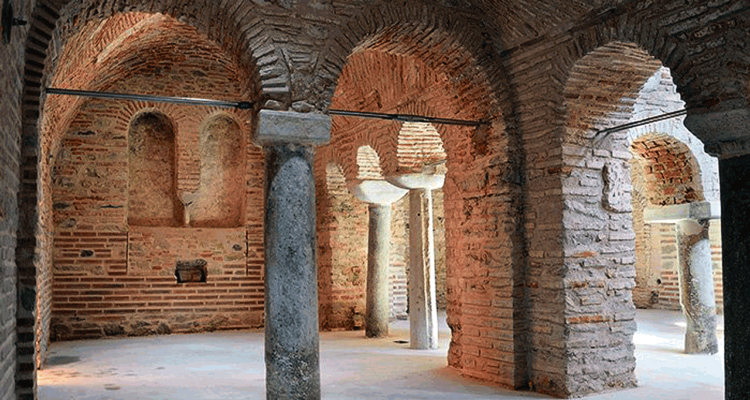The Byzantine Bath of Thessaloniki is the only surviving bath of the Middle Byzantine period in the whole of Greece. It dates between late 13th and early 14th century, and is included in the list of UNESCO World Heritage Sites. It is located in the Koule Kafe district of the Upper Town, quite close to other Byzantine monuments of the city.
It is a rectangular building consisting of three main rooms, each of which is divided into two apartments. The first room, the vestibule of the building, was cold and had smaller changing rooms. The second room functioned as a preparation area before the bath and was at a room temperature. Finally, the third room was warm and was the bath. Hot air was circulating underground as a natural underfloor heating, while it was also regulating the temperature of each room through the wall vents. According to historical sources, it was a public bath used by the people n the neighborhood and functioned alternately as a men’s and a women’s bath.
It operated for about seven centuries. Its operation continued even during the period of the Turkish occupation, during which it was known as “the Koule Kafe Bath”, but with some changes due to the religious traditions of the Muslims. More specifically, the Quran mandates the use of running water. For that reason, its wash-basins, which were a characteristic feature of Byzantine baths, were removed. It ceased operation in the 1940s and was then abandoned for many years.
In 1952, it was declared a preserved monument by the Ministry of Culture, while in the 70s the Archaeological Service carried out some exploratory work, which resulted in the uncovering of one of its sides, which due to the height difference was mostly buried. Its restoration was completed in 2014 by the Ephorate of Antiquities of the City of Thessaloniki.
Copyright 2023 © Created By Diadyktio, All Rights Reserved.
To provide the best experiences, we and our partners use technologies like cookies to store and/or access device information. Consenting to these technologies will allow us and our partners to process personal data such as browsing behavior or unique IDs on this site and show (non-) personalized ads. Not consenting or withdrawing consent, may adversely affect certain features and functions.
Click below to consent to the above or make granular choices. Your choices will be applied to this site only. You can change your settings at any time, including withdrawing your consent, by using the toggles on the Cookie Policy, or by clicking on the manage consent button at the bottom of the screen.

Congratulation!